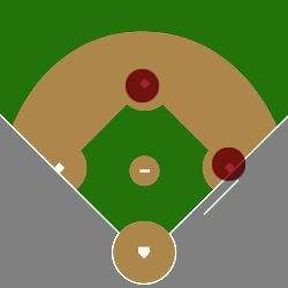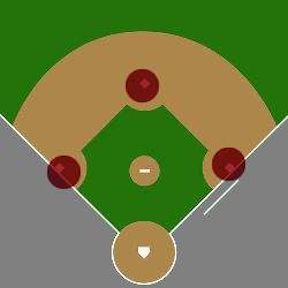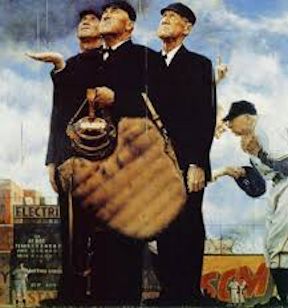 Infield Fly Rule
Infield Fly Rule
The infield fly rule is pretty simple. The important thing is recognizing when you are in an infield fly situation. When you are, signal your partner to ensure that you're both mentally ready to call it if you see it.
You are in an infield fly situation when these two conditions are met:
- First, you have fewer than two outs.
- Second, you have runners on first and second, or bases loaded, as shown here:


When both of these conditions are met then any high pop-up that "can be caught by an infielder with ordinary effort" invokes the infield fly rule (IFF). The batter is out but the ball remains live, and in all other respects it is simply a fly ball. I emphasized the phrase "with ordinary effort" because ordinary effort means different things at different levels. Ordinary effort for a ten-year-old is much different than for an eighteen-year-old varsity high school player. This factors into your judgment.
The point of the infield fly rule is to protect the offense. It sounds counter-intuitive that calling a batter out is protecting the offense, but in fact the infield fly rule prevents the defense from "accidentally-on-purpose" misplaying the fly ball, then getting an easy double- or triple-play.
The proper mechanic for calling the infield fly is to point straight up with your right arm and calling as loudly as possible "Infield fly! Batter's Out!" If the fly ball is coming down close to one of the foul lines, say instead "Infield fly if fair!" If the ball drops uncaught in foul territory, this is just an ordinary foul ball (the batter is not out), so just wave off the infield fly.
A few important points about the infield fly rule
- The rule says that an infield fly is a ball that "can be caught by an infielder …," but that does not mean that it must be caught by an infielder. Particularly at higher levels, a deep infield fly might be taken by an outfielder coming in. Remember, infield fly is a judgment call.
- An infield fly is not judged by arbitrary markings on the field, such as the infield grass line. You're going to face situations where you call IFF outside the grass line and a coach will scream something like "he's not in the infield!" Ignore him. He doesn't know what he's talking about.
- If the infield fly falls in foul territory (is a foul ball), the rule is waved off and the batter is not out. It's just a foul ball. If caught in foul territory, however, it is simply a caught fly ball – the batter is out, the ball is live, and runners may advance at their peril after tagging up.
- The effect of calling an infield fly is simply this: by calling the batter out, you take the force play off the runners on base. The ball is live, and the runners are free to advance at their peril, either immediately (if the IFF is not caught) or after tagging up (if it is).
- A bunt or attempted bunt can never be an infield fly, no matter how high it pops up. A blooper to the infield is also not an infield fly. How, then, do you recognize an infield fly? Well, my approach is this: If I can look up as the ball rises, then look down quickly to see if a fielder is handling it, and then look up again as the ball reaches its apex, then I have an infield fly. That's a bit fuzzy, I know, but it's the best I can do. A little bit of experience will get you comfortable with calling infield flies.
- At lower (meaning younger) levels of baseball the players (and coaches, too) may not be familiar with the infield fly rule so, when you call it, confusion may ensue and all hell break loose. When this happens your first instinct might be to call "Time" to kill the ball. Don't do it! Instead, let the chaos ensue, but pay close attention to what takes place; call outs on runners tagged off base, if that's what happens, and when all action has stopped you can handle the inevitable argument. Your response to the argument is twofold: First, explain the infield fly rule. Second, explain that players and coaches, not umpires, are responsible for maintaining situational awareness.

